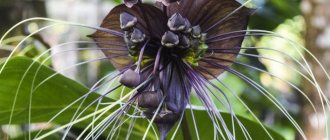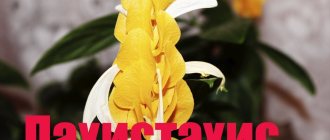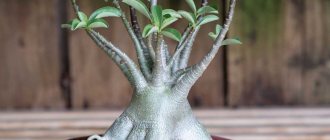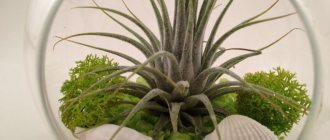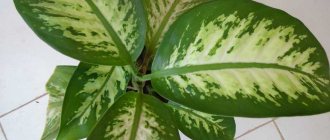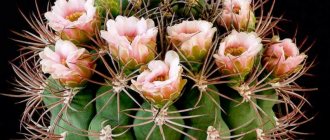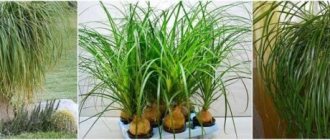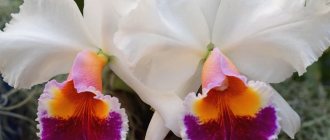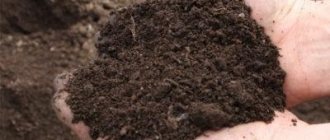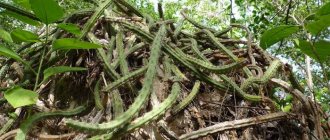Strelitzia is a unique, brightly colored plant that is native to South Africa. The beautiful flower resembles a colorful bird, hence its name. This interesting plant grows to a height and width of 1.5 m.
Bird of paradise is one of the most colorful plants that can be grown at home. It is a close relative of the banana plant, getting its name from the splayed, pointed flowers that resemble a bird in flight. For many years, Strelitzia was considered a collector's plant.
Description of decorative culture
Today Strelitzia is used for growing at home. This indoor plant adds bright notes and exquisite details to the interior. However, when choosing a flower, it is necessary to take into account the height of the adult plant. It can exceed 2 m. The leaf plates have a length from 50 to 90 cm. In the lower part they are tightly located around the root collar.
According to the description of the flower, its inflorescences are located on long peduncles. They have an axillary structure, externally resembling a continuing stem. In the structure of the flower, an asymmetrical perianth is observed, which is complemented by six parts.
The flowers are a combination of bright orange, blue and red. Their length can reach 10-20 cm. The flowering period is from 1 to 3 months. At the age of 4 years, the flower can bloom twice a year. The photo of Strelitzia reginas shows a flowering plant.
In the wild, this ornamental crop consists of dense thickets of evergreen perennials. Some species can reach a height of more than 3 m.
The plant has beautiful inflorescences and powerful leaves. Inside them there is juicy and watery pulp. The leaf mass has an oval shape. The leaf color can vary from dark green to bluish-blue.
Outwardly, they bear some resemblance to a banana tree. Their petioles are much longer. They range from 40 to 65 cm in length. For home cultivation, varieties with compact sizes are chosen. An adult plant, if all recommendations are followed, will not exceed 1.5 m in height.
Reproduction of strelitzia
Strelitzias are propagated in three ways - by seeds, by dividing the bush during transplantation and by separating side shoots. You can try to find seeds in the store. It is imperative to pay attention to the packaging date, since only fresh seeds germinate. The seed shell is very hard; it is better to sand it with sandpaper or keep it in warm water for a day. Sow the seeds in a light, loose soil mixture consisting of sand, peat and steamed sawdust. After sowing, the planting container is placed in a plastic bag. Seeds germinate within 1 – 1.5 months at a soil temperature of 23 – 26°C. Immediately after the seedlings appear, place the pots in a bright and warm place, remove the plastic bag and water generously with warm water. Over the course of a month, the air temperature is gradually reduced to room temperature. Young seedlings tolerate picking (and later transshipment) well into larger pots. They grow fast. It is better for seedlings to spend the first two winters in a warm place. A cool winter is beneficial only for mature and strong plants. Seedlings of Strelitzia royale bloom in the fourth year, other species - later.
When replanting in spring or summer, you can divide the overgrown bush. Each division must have at least one new shoot. The new plant will bloom in 3-4 years. This technique helps to rejuvenate old plants.
During propagation, lateral layering is also used, which turns into flowering plants within a few years.
Source
Subtleties of home growing
Home care consists of several important factors. Following the recommendations allows you to enjoy the decorative qualities of the flower for a long time. They consist of the following requirements:
Temperature compliance
A houseplant is highly dependent on the temperature in the enclosed space. Experts recommend sticking to 22-25 degrees in the summer. During the dormant period, the flower needs a temperature of at least 10 degrees.
Strelitzia feels comfortable in the fresh air. That is why the room in which the container with the flower is located needs to be regularly ventilated.
Lighting
Plants require bright lighting. In summer, additional devices will be needed to disperse the light rays;
Regularity of watering
How to water a flower? For active growth and abundant flowering, it is necessary to regularly moisten the soil substrate. To do this, use filtered liquid at room temperature. The filler must have drainage components that allow excess moisture to be removed. From October to February, watering is reduced to once a week.
Humidity level
Paradise culture needs high humidity. Its indicator should reach 60-70 percent. In hot summers, the leaves should be regularly sprayed with water. Particular attention must be paid to the cleanliness of the sheet plates. The presence of dust reduces the rate of growth and metabolic processes.
Soil composition
Strelitzia reginae prefers a nutrient substrate. Its pH should be neutral. When replanting, you need to prepare the filler for the flower pots yourself. To do this, use one part of humus, river sand, two parts of forest humus and compost.
Experts recommend purchasing soil for planting ornamental crops from specialized gardening departments.
Diseases and pests
Birds of paradise are sensitive to nuisance aphids and spider mites, but these pests are easy to spot and eliminate. Simply wipe the leaves with a soft cloth or warm soapy water. Avoid alcohol and aerosol pesticides, as they can damage the finish of the leaves.
General care tips
Lack of sunlight or moisture can prevent flowers from developing.
Clean the leaves regularly with a soft cloth. Dust can clog leaf pores and hinder photosynthesis.
Bird of paradise is slightly toxic, so avoid contact with plant sap and keep away from small children and animals.
Selection of capacity
Experts advise purchasing large containers. The fact is that the root system of indoor Strelitzia flowers develops quickly. The main root is a taproot. I gradually braid the secondary root shoots all around.
It is recommended to replant the flower after 5 years. It is recommended to pay special attention to the drainage holes at the bottom of the product. They allow you to remove excess moisture after watering.
The diameter of the pot should be twice the size of the root system. This space will be enough until the next transplant.
Chocolate space
The plant, originally from Mexico, received the Russian name Cosmeya, consonant with the official botanical Cosmos with the prefix “chocolate” for the unique color of the petals and smell. Cosmos is reluctant to reproduce under natural conditions, its seeds have poor germination, and its sprouts are very tender. Therefore, the attractive, fragrant flower was completely exterminated in its homeland.
By the beginning of the 20th century, a single bush remained in Latin America, from which scientists, who realized it, began the revival of a unique species. A plant with the smell and color of chocolate can now be found on all continents. Thus, all the cosmos flowers in the world have one common ancestor.
It was sown artificially in the fields:
- South America;
- USA;
- Mexico.
Today, chocolate cosmos fields are protected by law.
Feeding frequency
During active growth, Strelitzia needs regular feeding. For this purpose, organic and mineral compositions of complex fertilizers are used. The dosage selection is calculated based on the age of the flower and its characteristics. On the back of the package, as a rule, there are detailed instructions for using mineral products.
Between September and December, the addition of nutrients is stopped. At this time, the plant begins a dormant period. The addition of any nutritional compounds will not bring the desired result, but on the contrary, it can reduce the rate of formation of flower stalks and shorten the flowering period.
Saffron
Botanists determine the origin of the rare and expensive flower from a species of crocus that grew in Greece on the island of Crete. The plant itself is small and not very different from most bulbous primroses. The entire value of saffron lies in the thin, few purple stigmas located inside the spring flower.
A herbaceous plant no higher than 10 cm, with a bud from 3 to 5 cm, grows from a small bulb. Saffron petals are purple. The calyx of a flower usually contains 3 precious anthers, which must be collected at a strictly defined moment. The spice, obtained from hand-picked purple stigma threads, has always been worth its weight in gold.
Saffron was previously called “red gold”; it was credited with miraculous powers; it was used to dye the clothes of rulers and clergy. The concept of “saffron clothes” comes from the method of obtaining the unique color of fabrics. In India and throughout the world, saffron is still considered one of the most expensive spices.
A kilogram of floral raw materials costs at least 500 rubles.
Crocuses of 80 species, of various colors, grow today on all continents as garden flowers. They also grow in natural conditions, and some are listed in the Red Book. But the spice is obtained only from one cultivated variety, bred for artificial cultivation. There are no wild saffron varieties of crocuses.
Don't miss the most popular article in the section: Kamchatka on the map of Russia. What makes the peninsula unique, interesting facts, geography.
Strelitzia transfer
It is recommended to replant young seedlings of Strelitzia royale once every five years before the onset of the growing season. To do this, select a container that should be twice as large as the diameter of the roots.
Transplanting adult bushes is a rather complex and painstaking process. In this case, the transshipment method is used to reduce the load on the root system. The drainage drain must be increased by one and a half times. Experts recommend removing old pebbles and expanded clay.
In a new pot, it is necessary to replace the soil substrate and drainage components. In this way, it is possible to prevent the proliferation of pathogenic microflora on the surface of the root system of the ornamental crop.
If the root system of an adult plant is severely damaged or has rotten parts, then these areas are removed using a sharp knife and the cut areas are treated with manganese or charcoal. In this way, it is possible to prevent the death of the entire bush.
Caring for Strelitzia reginas during the growth period
Place. Summer is an important period in the life of Strelitzia. In nature, it grows in the subtropics of South Africa. Where there are wet and open places: clearings and river banks. Strelitzia is also found in forest shade; it can be seen even on overgrown mountain slopes. In order for this plant to be comfortable in the summer, it needs to be watered abundantly and the leaves must be sprayed frequently. In summer, Strelitzia can be left on the windowsill of a north window, in a slightly shaded place on the loggia and in the room. At this time, she does not get worse from some lack of light. However, Strelitzia must be provided with sufficient humidity, nutrition, moderate light and heat.
Feeding. It is better to alternate fertilizing with mineral and organic fertilizers. An excellent food for her is fermented slurry (once a month).
Photo of Strelitzia
Gibraltar tar
More than 400 species of resins from the Clove family grow throughout the temperate and cold zones of the globe. But only one of them has the status of a rare flower - Gibraltar.
The herbaceous sticky stems of the plant are covered with sessile opposite leaves. The shoots are crowned with loose small flower clusters. The five petals gathered into a bud have a deep cut in the center and look like strongly elongated hearts.
The plant does not make an impression either in size or color. Gibraltar gum is a small, unassuming flower, famous for being considered a long-extinct species. The habitat of the delicate plant was the steep cliffs of Gibraltar, where only climbers saw it. Gradually, the flowers became fewer and fewer until they remained only in old photos.
A pleasant discovery for science was the discovery in 1994 of one tar bush on the same rocks. Botanists managed to collect the seeds of a unique culture and revive a species almost lost to nature.
Orchid "Kinabalu Gold"
The rarest and incredibly expensive flower in the world has another name - Paphiopedilum Rothschild. This amazing plant lives in only one place on the planet, on the slope of Mount Kinabalu, one of the national parks of Borneo (Malaysia). A variegated orchid of a predatory appearance with stripes and horizontal tendrils cannot be confused with any other.
The flower regularly appears at exotic flower exhibitions around the world, making up the pride of the best collections and greenhouses.
Its sprout cannot be obtained for less than 5 thousand dollars, and upon reaching 15 years, the price of the plant rises to 50 thousand. Only at this age does Kinabalu begin to bloom. Therefore, the culture reproduces very slowly. Up to 6 large, flat-opening flowers bloom on one shoot. The diameter of the largest orchid reaches 13 cm.
The soft yellow petals are decorated with burgundy stripes and dotted patterns. The variegated color of Kinabalu Gold resembles a colony of aphids, which in nature attracts parasitic insects for pollination. The species is protected by law, but its population in Borneo is rapidly declining.
